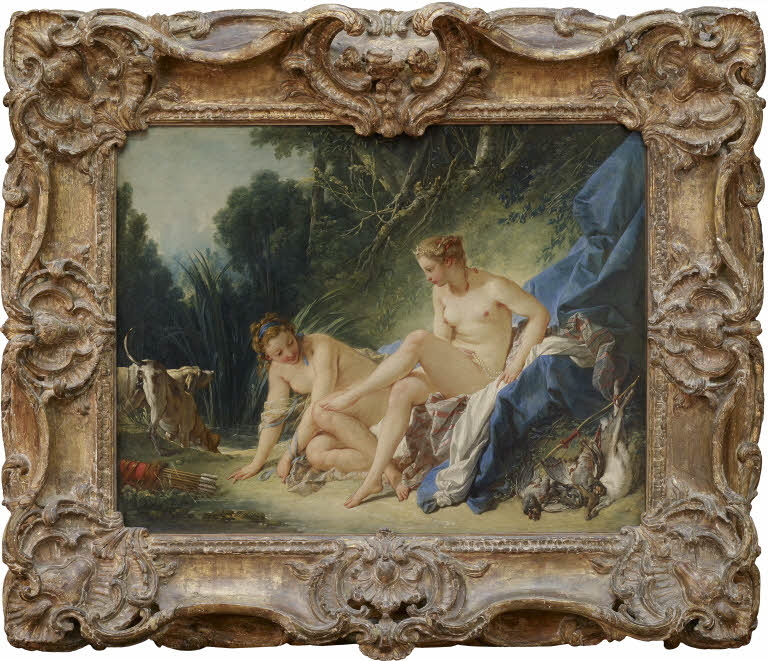The Pastoral
A defining genre of Rococo painting is the pastoral scene, or a picture that portrays an idealized countryside or landscape, often relating to shepherds and other country folk ("Pastoral"). Often, along with a lush countryside, these pieces would include scenes of nudity. An artist named François Boucher studied under Watteau; “He devoted his main attention to pastoral idylls and the fete-galante genre, and, particularly in his early works, landscape played a significant role” (Barea and Voss 81). Pastoral scenes; however, especially of Rococo, lead to new kinds of compositional structure, “The fundamental hierarchy of figure to ground, from which emerges the potential of pictorial narrative, dissipates in the softened boundaries and material fluidity of the Rococo picture” (Sterret 2). For instance, Edward Sterret goes on to describe how artists began to move away from realistic perspective in figure-ground relationships. These ambiguities of the background help to further emphasize a subject and direct the eye of the viewer (14). In these next paintings, it is clear that these artists were experimenting with new background-foreground relationships, compositions, and colors.
In Boucher’s Diana Leaving Her Bath, he makes this simple subject matter interesting by adding elements of contrast and dynamism. Something that makes this painting quintessentially Rococo is the contrast of the subject’s creamy, white skin tone with the blues and dark greens of the background. Furthermore, Diana and the nymph’s bodies are smooth and lustrous compared to the textured background of the foliage and grass. The foliage seems to perfectly frame them in their position, creating a kind of vignette around the figures. Boucher also experiments with composition. Though the two figures are in the middle of the painting, he creates exciting, detailed, interwoven diagonals that intersect and draw the eye. The calves of Diana point to the bent knee of the nymph; the folds in the blue cloth lead the eye down to the bend in her elbow and eventually to her hair and breasts. Boucher, through diagonals, creates a composition that the eye can dwell on and be entertained by, and creates further emphasis on the figures through the contrasting colors and values.
In The Bathers by Jean Honoré Fragonard, he utilizes very similar techniques to Boucher. The skin tones of the figures contrast in both color and texture to the background; these women are creamy white and smooth. However, Fragonard takes it a step further by adding pinks and reds to the women’s bodies in order to further highlight the curvy shapes. Similarly, he uses diagonals in the composition to move the eye around the piece, which makes it interesting to look at. Something that he takes quite a bit further than Boucher, however, is the relationship of the background to the foreground. A new development in Rococo art was, ““a willful erasure of the realism of perspectival composition, and in this erasure, a radical break from 14 the conventions of pictorial representation” (Sterret 14). If one observes the foliage, clouds, and waters that surround the ladies, there is an ambiguous sense of space. There is almost no perspective or realism to distinguish the background as being on a different plane than the figures, except color shifts and overlapping. This kind of blurred or ambiguous background became more common in this time, and was used to place more emphasis on the subjects in the foreground. The landscape visually fades away, and the figures become the focal point. The introduction of a new technique to the pastoral genre shows the freedom with which Rococo painters experimented with new techniques.
In The Swing, also by Fragonard, he again uses these techniques. The woman's pink dress contrasts beautifully with the greens of the background, the diagonals and framing help to make the composition interesting, and he uses ambiguity of the trees in the background to further emphasize the subject. However, what makes this scene different from other pastoral scenes are the subject and storyline as well as the details of the painting. No longer is the landscape about peaceful country life but a misbehaving upperclassman. The woman pictured is wearing an extravagant dress, sunhat, and does not seem to blink an eye when her expensive shoe flies off her foot. Fragonard also puts a significant amount of detail into this painting, especially compared to The Bathers. In some of the foliage, one can make out every leaf, there are picturesque statues and a man tucked away in the garden. He paints the leftward man as if he has just fallen out of an attempt to respect this woman. All in all, Fragonard paints this pastoral scene very differently, and creates an iconic image.
Boucher’s The Bridge and Blind Man’s Bluff are prime examples of more typical pastoral work. These both incorporate lush greens with abundant foliage. Furthermore, he paints subjects that would be more common to the countryside, such as the cow in The Bridge. Both paintings have horizon lines in a similar place; however, Blind Man’s Bluff has a clear, more traditional linear perspective than that of The Bridge, which uses some atmospheric perspective to blur the horizon line. Though typical of pastoral scenes, it is interesting to compare these to the paintings above, such as Diana Leaving Her Bath. It is clear that all of these paintings are so different yet are similar in genre. Rococo truly allowed artists to experiment in this genre with new kinds of composition and even subject matter. The pastoral became more than a landscape but a place where anything could happen, a place of fantasy, and a place of freedom.




